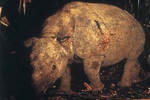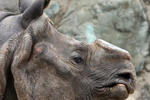One-horned rhino (Rhinoceros unicornis) with its horn cut off to protect it from poachers
Nearly 200 rhinos have been killed in South Africa through the first six months of 2011, reports TRAFFIC, the wildlife trade monitoring network.
Statistics from South Africa’s national parks department show that rhino poaching is on track to break 2010’s record of 333 rhinos killed.
126 rhinos have been killed in Kruger National Park. 146 were killed in the park in 2010.
TRAFFIC says rhino poaching is being conducted by criminal syndicates that sell rhino horn to consumers in China and Vietnam, who believe rhino horn cures ailments despite research indicating that rhino horn offers nothing more than a placebo effect.
“Poaching is being undertaken almost without exception by sophisticated criminals, sometimes hunting from helicopters and using automatic weapons,” said Dr Joseph Okori, WWF’s African Rhino Program Coordinator, in a statement. “South Africa is fighting a war against organized crime that risks reversing the outstanding conservation gains it made over the past century.”
“The poaching surge shows no sign of abating,” added Tom Milliken, Elephant & Rhino Program Coordinator with TRAFFIC. “Only a concerted international enforcement pincer movement, at both ends of the supply and demand chain, can hope to nip this rhino poaching crisis in the bud.”
TRAFFIC is a run by WWF and the International Union for Conservation of Nature (IUCN).
Related articles
Eating rhino horn sends woman to hospital
(06/30/2011) A Vietnamese woman ended up in the hospital after consuming rhino horn, reports savingrhinos.org. Used for a rash around her mouth, the rhino horn instead caused a serious allergic reaction, including reddening skin, itching, and fever. Listed under the Convention on International Trade in Endangered Species of Wild Fauna and Flora (CITES), rhino horn is illegal to purchase or sell worldwide.
How do we save the Sumatran rhino?

(06/06/2011) Some conservation challenges are more daunting than others. For example, how do you save a species that has been whittled down to just a couple hundred individuals; still faces threats such as deforestation, poaching and trapping; is notoriously difficult to breed in captivity; and is losing precious time because surviving animals are so few and far-apart that simply finding one another—let alone mating and successfully bringing a baby into the world—is unlikely? This is the uphill task that faces conservationists scrambling to save the Sumatran rhino (Dicerorhinus sumatrensis). A new paper in Oryx, aptly named Now or never: what will it take to save the Sumatran rhinoceros Dicerorhinus sumatrensis from extinction? analyzes the conservation challenge, while putting forth a number of recommendations.
Down to 50, conservationists fight to save Javan Rhino from extinction

(05/17/2011) Earlier this year, the International Rhino Foundation launched Operation Javan Rhino to prevent the extinction of the critically endangered Javan Rhinoceros (Rhinoceros sondaicus), formerly found in rain forests across Southeast Asia. Operation Javan Rhino is a multi-layered project which links field conservation, habitat restoration, and management efforts with the interests of local governments and communities. The following is an interview with Susie Ellis, Executive Director of the International Rhino Foundation.
Belief and butchery: how lies and organized crime are pushing rhinos to extinction

(05/11/2011) Few animals face as violent, as well organized, and as determined an enemy as the world’s rhinos. Across the globe rhinos are being slaughtered in record numbers; on average more than one rhino is killed by poachers everyday. After being shot or drugged, criminals take what they came for: they saw off the animal’s horn. Used in Traditional Chinese Medicine, which claims that it has curative properties, rhino horn is worth more than gold and cocaine on the black market. However, science proves all this cash and death is based on a lie. ‘There is no medicinal benefit to consuming rhino horn. It has been extensively analyzed in separate studies, by different institutions, and rhino horn was found to contain no medical properties whatsoever,’ says Rhishja Larson.
Rhino horn price matches cocaine
(02/13/2011) As a rhino poaching epidemic continues throughout Africa and Asia, the price of rhino horn has matched cocaine, according to the UK’s Daily Mirror. The price of illegal powdered rhino horn—obtained by killing wild rhinos and sawing off their horns—has hit £31,000 per kilo or nearly $50,000 per kilo. The price has already topped that of gold.
Last year worst yet for rhino killings in South Africa
(01/19/2011) Three hundred and thirty-three rhinos were killed in South Africa last year, the highest number yet. Ten of the rhino were black rhinos, which are listed as Critically Endangered by the IUCN Red List, the rest were white rhinos, listed as Near Threatened. In total South Africa has over 20,000 rhinos.
Chinese court sentences rhino horn smuggler to 12 years
(10/07/2010) A traditional Chinese medicine businessman has been sentenced to 12 years in prison for attempting to smuggler rhino horn from Vietnam to China, according to Saving Rhinos which has been following the case on ChinaCourt.org.
Fighting poachers, going undercover, saving wildlife: all in a day’s work for Arief Rubianto

(09/29/2010) Arief Rubianto, the head of an anti-poaching squad on the Indonesian island of Sumatra best describes his daily life in this way: “like mission impossible”. Don’t believe me? Rubianto has fought with illegal loggers, exchanged gunfire with poachers, survived four days without food in the jungle, and even gone undercover—posing as a buyer of illegal wildlife products—to infiltrate a poaching operation. While many conservationists work from offices—sometimes thousands of miles away from the area they are striving to protect—Rubianto works on the ground (in the jungle, in flood rains, on rock faces, on unpredictable seas, and at all hours of the day), often risking his own life to save the incredibly unique and highly imperiled wildlife of Sumatra.
Already illegal, one man tests poisoning rhino horn too
(07/28/2010) Given the epidemic of rhino poaching across Africa and Asia, which has placed four out of five species in jeopardy of extinction, one fed-up game manager wants to take the fight beyond the poachers to the consumer. Ed Hern, owner of the Lion and Rhino Park near Johannesburg, told South Africa’s The Times that he has begun working with a veterinarian on injecting poison into a rhino’s horn to consumers. He told The Times that people who consumed poisoned rhino horn “would get very sick or die”.
Elle MacPherson promotes consumption of illegal rhino horn [warning: graphic image]
(07/02/2010) Despite a number of scientific studies showing that rhino horn has no curative properties, supermodel, entrepreneur, and recent host of Britain’s Next Top Model, Elle Macpherson, says she ingests powdered rhino horn because: ‘[it] works for me’. In an interview with The Sunday Times via Twitter, Elle Macpherson says the illegal substance tastes like ‘crushed bone and fungus’.
Face-to-face with what may be the last of the world’s smallest rhino, the Bornean rhinoceros

(12/01/2009) Nothing can really prepare a person for coming face-to-face with what may be the last of a species. I had known for a week that I would be fortunate enough to meet Tam. I’d heard stories of his gentle demeanor, discussed his current situation with experts, and read everything I could find about this surprising individual. But still, walking up to the pen where Tam stood contentedly pulling leaves from the hands of a local ranger, hearing him snort and whistle, watching as he rattled the bars with his blunted horn, I felt like I was walking into a place I wasn’t meant to be. As though I was treading on his, Tam’s space: entering into a cool deep forest where mud wallows and shadows still linger. This was Tam’s world; or at least it should be.